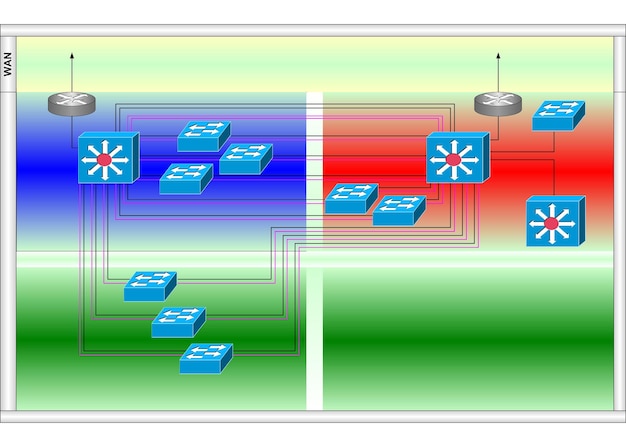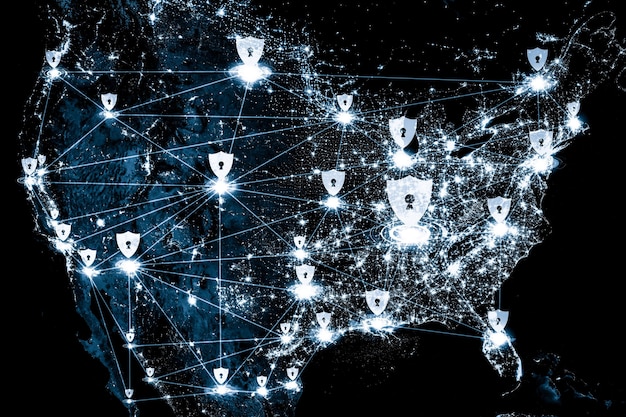Latest Cybersecurity Threats Targeting US Infrastructure & Mitigation

Advertisements
The latest cybersecurity threats targeting US infrastructure involve sophisticated nation-state actors and organized cybercriminals employing ransomware, supply chain attacks, and critical infrastructure disruption, necessitating robust, collaborative, and adaptive mitigation strategies.
Advertisements
The digital arteries of the United States’ infrastructure are constantly under siege. From power grids to financial systems, the interconnectedness that defines modern society also presents an inviting target for malicious actors. Understanding what are the latest cybersecurity threats targeting US infrastructure and how can they be mitigated is not just a technical challenge, but a critical national security imperative that demands constant vigilance and proactive defense.
The Evolving Landscape of Cyber Warfare and Espionage
The nature of cyber threats has fundamentally shifted. What once involved nuisance hacking has matured into sophisticated, state-sponsored operations aimed at strategic disruption, espionage, and economic sabotage. These actors possess significant resources, expertise, and patience, making their attacks incredibly difficult to detect and defend against.
Advertisements
Nation-state actors, in particular, are increasingly leveraging cyber capabilities as instruments of foreign policy. Their objectives often extend beyond financial gain, encompassing intelligence gathering, intellectual property theft, and the destabilization of adversaries. This makes critical infrastructure an attractive target, as its disruption can have cascading and far-reaching impacts on a society.
Advanced Persistent Threats (APTs)
Advanced Persistent Threats (APTs) are a prime example of this evolution. These are stealthy, continuous computer hacking processes, often targeting specific entities for long-term intelligence gathering rather than immediate financial gain. APT groups, typically state-sponsored, employ a wide array of techniques to gain access, establish a foothold, and exfiltrate data undetected over extended periods.
- Reconnaissance and Initial Access: Extensive research on targets, often through spear-phishing, supply chain compromises, or exploiting zero-day vulnerabilities.
- Establishment of Footholds: Deploying custom malware, backdoors, and rootkits to maintain persistent access within the compromised network.
- Lateral Movement and Privilege Escalation: Moving through the network, escalating user privileges, and mapping the infrastructure to identify critical systems.
- Data Exfiltration and Long-term Presence: Slowly siphoning off data, often encrypted or obfuscated, and maintaining a covert presence for future operations.
The detection of APTs requires sophisticated threat intelligence, continuous monitoring, and behavioral analytics, as their tactics often bypass traditional signature-based security tools. Mitigating them involves a multi-layered defense strategy, focusing on early detection and rapid incident response to minimize their dwell time within networks.
Beyond APTs, the digital battleground is also witnessing increased exploitation of supply chains. Attackers target less secure elements within an organization’s ecosystem – third-party vendors, software components, or hardware manufacturers – to gain access to the primary target. This indirect approach adds layers of complexity to defense, as organizations must now vet the security posture of their entire supply chain, not just their immediate perimeter. The SolarWinds attack in late 2020 served as a stark reminder of the devastating potential of such compromises, affecting numerous government agencies and private companies within the US.
Ransomware: A Persistent and Evolving Menace
While nation-state attacks pose a strategic threat, ransomware remains a pervasive, disruptive, and financially debilitating concern for US infrastructure. Once a tool of opportunistic cybercriminals, ransomware operations have evolved into highly organized, often state-adjacent, “Ransomware-as-a-Service” enterprises, targeting critical sectors with increasing ferocity.
The shift from indiscriminate attacks to finely targeted “big game hunting” has made ransomware far more impactful. Attackers now conduct extensive reconnaissance, compromise networks, and exfiltrate sensitive data before deploying the ransomware. This “double extortion” tactic, where data is both encrypted and threatened with public release, significantly amplifies the pressure on victims to pay the ransom, making recovery incredibly challenging even with robust backups.
Tactics and Consequences of Ransomware Attacks
Modern ransomware attacks are characterized by their sophistication in gaining initial access and their aggressive post-compromise actions. Phishing campaigns, exploiting unpatched vulnerabilities, and compromised remote desktop protocols (RDP) are common entry points. Once inside, attackers use legitimate tools (living off the land) to evade detection, move laterally, and disable security software before encrypting systems.
- Targeted Operations: Shifting focus from broad, untargeted campaigns to specific, high-value organizations within critical sectors.
- Double and Triple Extortion: Encrypting data, threatening to leak it, and sometimes launching denial-of-service attacks or contacting customers/partners.
- Supply Chain Vectors: Exploiting vulnerabilities in third-party software or services to compromise multiple organizations simultaneously.
- Critical Service Disruption: Direct impact on essential services, leading to outages in healthcare, energy, transportation, and public utilities.
The consequences of ransomware go beyond financial loss from ransom payments. Operational downtime can have significant economic repercussions, disrupt supply chains, and, in some cases, pose direct risks to public safety. The Colonial Pipeline attack in 2021, which led to widespread fuel shortages, underscored the vulnerability of critical infrastructure to such threats and demonstrated the potential for significant societal disruption.
Mitigation of ransomware depends heavily on a combination of technical controls and organizational resilience. Robust backup and recovery plans are paramount, ensuring that operations can be restored without paying the ransom. Implementing strong identity and access management, multi-factor authentication (MFA), and regular security awareness training can significantly reduce the attack surface. Furthermore, pro-active threat intelligence sharing between government agencies and private entities is crucial for anticipating and defending against emerging ransomware variants and attack methodologies.
Threats to Operational Technology (OT) and Industrial Control Systems (ICS)
Historically, Operational Technology (OT) and Industrial Control Systems (ICS), which manage and control physical processes in critical infrastructure, were largely isolated from traditional IT networks. This “air gap” offered a level of security. However, the drive towards digitalization, efficiency, and remote management has increasingly blurred the lines between IT and OT, creating new vulnerabilities previously unimaginable.
Connecting OT environments to IT networks for data analytics, remote monitoring, and improved operational efficiency introduces significant attack vectors. Cybercriminals and nation-state actors are increasingly aware of the potential for exploiting these converged environments, as disruption to OT can have immediate and tangible physical consequences, from power outages to chemical spills.
Specific Vulnerabilities and Attack Vectors
OT environments often suffer from unique security challenges. Legacy systems may run outdated software with known vulnerabilities that cannot be easily patched due to system stability requirements or vendor limitations. Specialized protocols used in industrial settings are often not designed with security in mind, lacking encryption or authentication mechanisms. Furthermore, OT personnel may lack extensive cybersecurity training compared to their IT counterparts.
- IT/OT Convergence Risks: The direct or indirect connection of operational networks to enterprise IT networks, creating pathways for cyberattacks.
- Legacy System Vulnerabilities: Outdated hardware and software in critical systems that are difficult or impossible to patch without disrupting operations.
- Lack of Visibility: Inadequate monitoring and logging capabilities within OT networks, making detection of malicious activity challenging.
- Insider Threats: Malicious or negligent actions by employees or former employees with access to critical control systems.
Attacks on OT/ICS often involve gaining initial access through the IT network, then pivoting to the OT network to manipulate industrial processes. This could involve disrupting power generation, disabling safety mechanisms, or altering chemical compositions. The Stuxnet worm, though primarily targeting Iranian nuclear facilities, demonstrated the profound impact sophisticated malware could have on physical industrial systems, serving as a chilling blueprint for future attacks.

Mitigating threats to OT/ICS requires a specialized approach tailored to the unique characteristics of these environments. Network segmentation is crucial, creating logical and physical barriers between IT and OT networks. Implementing strict access controls, including multi-factor authentication for all remote access, is also vital. Regular security audits, vulnerability assessments, and the development of incident response plans specifically for OT environments are essential steps to bolster resilience. Collaboration between IT and OT teams, ensuring a shared understanding of risks and responsibilities, is perhaps the most important foundational element.
The Growing Threat of Cloud and AI-Driven Attacks
As US infrastructure increasingly adopts cloud computing and artificial intelligence (AI) for enhanced efficiency, resilience, and data analytics, these very technologies introduce new and complex cybersecurity challenges. Cloud environments, while offering scalability and flexibility, also present a shared responsibility model for security, where misconfigurations can lead to significant data breaches or system compromises. AI, a powerful tool for defense, is also being weaponized by adversaries.
The reliance on cloud services means that a single point of failure or compromise in a cloud provider’s infrastructure could have widespread impacts across multiple critical sectors. Furthermore, the sheer volume of data processed and stored in cloud environments makes them attractive targets for data exfiltration and intellectual property theft. Ensuring robust security within the cloud requires constant vigilance, proper configuration, and adherence to best practices.
New Attack Vectors via Cloud and AI
Threat actors are rapidly adapting to target cloud environments. This includes exploiting misconfigured cloud services, leveraging compromised credentials to gain access, or even targeting the underlying infrastructure of cloud providers themselves. The rapid deployment cycle in cloud environments also means that new vulnerabilities can emerge quickly, often before robust patches or security solutions are available.
- Cloud Misconfigurations: Incorrectly configured storage buckets, identity and access management (IAM) policies, or network security groups leading to unauthorized access.
- API Vulnerabilities: Exploiting weaknesses in application programming interfaces (APIs) used to connect cloud services and applications.
- AI Poisoning and Evasion: Malicious actors injecting bad data into AI models to corrupt their functionality or creating adversarial examples that bypass AI-powered security defenses.
- Deepfakes and AI-powered Social Engineering: Using AI to create highly convincing fake audio, video, or text to facilitate phishing, disinformation campaigns, or insider threats.
AI’s dual nature is particularly concerning. While AI can be used for anomaly detection, threat prediction, and automated responses, malicious actors are leveraging AI to automate their attacks, generate more convincing phishing emails, identify vulnerabilities at scale, and even develop novel malware. The generative capabilities of AI mean that the volume and sophistication of cyber threats are likely to increase exponentially, making human-led defense efforts increasingly difficult to scale.
To mitigate these evolving threats, organizations must adopt a “cloud-first” security mindset, implementing security measures natively within cloud environments. This includes rigorous access control, continuous security monitoring, and automated vulnerability management. For AI threats, investing in explainable AI (XAI) to understand model behavior, robust data validation, and adversarial AI research to anticipate and defend against AI-driven attacks will be crucial. Furthermore, developing human expertise in both cloud security and AI ethics is vital to harness the benefits of these technologies responsibly while minimizing their associated risks.
The Enduring Challenge of Insider Threats and Human Error
While external cybercriminals and nation-states dominate headlines, a significant and often underestimated threat to US infrastructure comes from within: insider threats and human error. Whether malicious or unintentional, actions by individuals with legitimate access to systems can lead to devastating breaches, data loss, or operational disruption. The complexity of modern systems and the constant pressure on employees increase the likelihood of inadvertent mistakes.
An insider threat can originate from a disgruntled employee seeking revenge, a financially motivated individual selling sensitive information, or even a well-intentioned employee inadvertently falling victim to a sophisticated phishing scheme. Human error, such as misconfiguring a server, clicking on a malicious link, or losing a sensitive device, accounts for a substantial percentage of security incidents across all sectors.
Mitigation Strategies for Internal Risks
Addressing insider threats requires a multi-faceted approach that combines technical controls with robust organizational policies and a strong security culture. It is not solely about surveillance but about creating an environment that minimizes opportunities for malicious acts and reduces the impact of accidental ones.
- Robust Access Controls and Least Privilege: Ensuring employees only have access to the systems and data absolutely necessary for their role.
- User Behavior Analytics (UBA): Monitoring patterns of user activity to detect anomalous or suspicious behavior that could indicate malicious intent or compromise.
- Security Awareness Training: Continuous and engaging training programs to educate employees about common cyber threats, phishing, social engineering, and safe computing practices.
- Strict Data Handling Policies: Clear guidelines and enforcement for how sensitive data should be handled, stored, and transmitted.
For unintentional human error, the focus shifts to creating user-friendly security processes, implementing automation where possible, and fostering a culture where mistakes are seen as learning opportunities rather than punitive events. Regular security audits of configurations and infrastructure, coupled with automated scanning tools, can help identify and remediate misconfigurations before they are exploited. Furthermore, fostering a security-first culture where employees feel empowered to report suspicious activities without fear of reprisal is critical.
The human element remains the weakest link in many cybersecurity defenses. Investing in comprehensive security awareness programs, implementing strong identity and access management (IAM) solutions, and fostering a culture of vigilance and accountability are paramount. Organizations must realize that technology alone cannot fully secure their infrastructure; it must be coupled with a well-trained, security-conscious workforce.
Collaborative Defense: The Path Forward for US Infrastructure Cybersecurity
Given the complexity, sophistication, and global nature of modern cybersecurity threats, no single entity—government or private—can effectively defend against them in isolation. A truly robust defense of US infrastructure necessitates an unprecedented level of collaboration, intelligence sharing, and public-private partnerships. This multi-stakeholder approach is crucial for building a collective resilience that can withstand and recover from even the most severe cyberattacks.
The concept of “collective defense” goes beyond simply sharing threat indicators. It involves coordinated incident response, joint research and development into new security technologies, and the sharing of best practices and expertise across sectors. This collaborative ecosystem can enhance situational awareness, accelerate threat detection, and improve the overall capacity for rapid recovery.
Key Pillars of Collaborative Mitigation
The US government has recognized this imperative, fostering initiatives like the Cybersecurity and Infrastructure Security Agency (CISA) and sector-specific Information Sharing and Analysis Centers (ISACs). These organizations play a vital role in disseminating threat intelligence, offering guidance, and coordinating responses during major incidents. However, their effectiveness hinges on the active participation and trust of private sector partners, who own and operate the vast majority of critical infrastructure.
- Enhanced Threat Intelligence Sharing: Rapid and effective sharing of Indicators of Compromise (IOCs), Tactics, Techniques, and Procedures (TTPs) between government and private entities.
- Public-Private Partnerships (PPPs): Formalized structures for collaboration, including joint training exercises, working groups, and research initiatives.
- Coordinated Incident Response: Developing common protocols and frameworks for responding to widespread cyber incidents, ensuring seamless communication and resource allocation.
- International Cooperation: Working with allied nations to address cross-border cybercrime, share intelligence, and enforce international norms in cyberspace.

Strengthening the cyber talent pipeline is also a critical component of collaborative defense. There is a significant shortage of skilled cybersecurity professionals, and addressing this gap requires concerted efforts from educational institutions, industry, and government. Initiatives that promote cybersecurity education, apprenticeships, and career pathways can help build the workforce necessary to meet future challenges. Furthermore, developing and deploying advanced cybersecurity technologies, including those based on AI and machine learning, requires substantial investment and collaborative development to ensure they are effective against evolving threats.
Ultimately, safeguarding US infrastructure is an ongoing journey that demands adaptability, innovation, and a continuous commitment to shared responsibility. By fostering deeper public-private partnerships, investing in human capital, and embracing a culture of proactive defense and resilience, the nation can significantly bolster its defenses against the complex and ever-present digital threats of the 21st century.
| Key Area | Brief Description |
|---|---|
| 🛡️ Evolving Threats | Nation-state APTs, sophisticated ransomware, and supply chain attacks are increasingly targeting critical infrastructure. |
| ⚙️ OT/ICS Vulnerabilities | Legacy systems and IT/OT convergence create unique risks for industrial control systems. |
| ☁️ Cloud & AI Risks | Misconfigurations in cloud environments and AI-driven adversarial attacks pose new challenges. |
| 🤝 Collaborative Mitigation | Public-private partnerships and intelligence sharing are vital for resilient defense. |
Frequently Asked Questions About US Infrastructure Cybersecurity
▼
Motivations vary, ranging from nation-state espionage and strategic disruption to cybercriminal financial gain (e.g., ransomware) and ideologically motivated hacktivism. Some attacks aim to steal intellectual property, while others seek to destabilize critical services. Understanding the motive helps in predicting attack vectors and developing targeted defenses.
▼
Ransomware’s unique impact on critical infrastructure stems from its ability to directly disrupt essential services, leading to physical consequences like power outages or fuel shortages, as seen with Colonial Pipeline. It also often employs “double extortion” by leaking sensitive data, increasing pressure beyond mere operational recovery.
▼
Human error remains a significant vulnerability, often leading to misconfigurations, accidental clicks on malicious links, or compromised credentials. Even well-intentioned actions can inadvertently create security gaps. Comprehensive security awareness training and user-friendly security protocols are crucial for mitigating this internal risk factor effectively.
▼
AI and cloud computing offer immense benefits in terms of efficiency, scalability, and advanced threat detection. However, they also introduce new vulnerabilities like cloud misconfigurations and AI-powered adversarial attacks (e.g., deepfakes, evasion techniques). This dual nature demands adaptive security strategies that leverage their strengths while mitigating their inherent risks.
▼
The vast majority of US critical infrastructure is privately owned, while intelligence on sophisticated threats often resides with government agencies. Public-private collaboration enables vital threat intelligence sharing, coordinated incident response, and collective development of resilient security practices, creating a unified front against shared adversaries and enhancing overall national security.
Conclusion
The landscape of cybersecurity threats targeting US infrastructure is dynamic and increasingly complex, driven by sophisticated nation-state actors, organized cybercriminals, and the rapid pace of technological innovation. From advanced persistent threats and evolving ransomware tactics to vulnerabilities in operational technology and the emerging risks of AI-driven attacks, the challenges are multifaceted. However, by embracing comprehensive mitigation strategies that prioritize robust technical controls, continuous staff training, and deep public-private collaboration, the United States can significantly enhance its resilience and secure its vital infrastructure against the digital threats of today and tomorrow. This ongoing effort is paramount for national security and economic stability.





